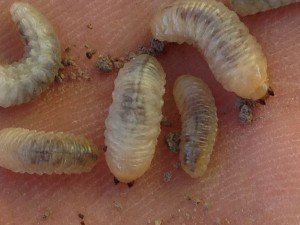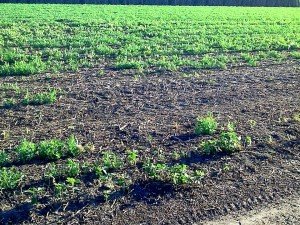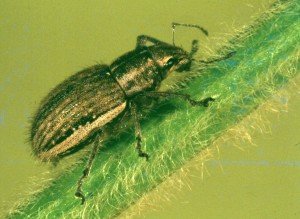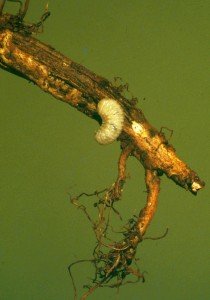The white-fringed weevil (Naupactus leucoloma) originates from South America and was first reported in NSW in 1932. Although generally associated with warm moist conditions, this pest is now found in many cropping areas throughout Australia and they appear to be increasing their range. Infestations often go unnoticed until crops are planted and once they are established they are difficult to eradicate.
Damage
White-fringe weevils cause problems in field crops as larvae that feed on lateral and taproots. They can cause major taproot damage which may result in loss of vigour as well as plant death. Damage to plant roots can also leave plants susceptible to root diseases. Adult weevils feed on leaves but cause little economic damage. Many pulse crops are susceptible to damage especially peanuts (they will also eat the pods), chickpeas, soybeans and field peas. Other susceptible crops include lucerne, cotton and maize. Crops are most susceptible to damage during the seedling/early vegetative stages as their roots are smaller relative to the size of the weevil larvae (12 mm when fully grown), and plants are more likely to be killed.
Damage symptoms observed in field pea crop at Bundaberg included wilted plants, dead plants and gaps in the plant stand. Closer inspection of damaged plants revealed larvae had chewed through plant roots/stems just below or at ground level.
Identification and lifecycle
Larvae are legless, up to 12 mm long and 6 mm wide with slightly curved grey-white bodies. They have yellow-brown heads which are retracted into the body so only the jaws are visible. The adult weevil has a snout, is 12mm long with a grey-brown body and has a light stripe on each side of the wing cover. Their wing covers are fused together and they cannot fly but can walk long distances. They emerge from the soil in summer.
Sampling for white–fringed weevils
Before planting, sample soils to determine presence of weevils. Sampling should be done in autumn or winter when larvae are large and easy to find, and before the next susceptible crop is planted. Using a spade, take a sample of soil and sift soil to find grubs. Repeat sampling at 10 areas throughout the paddock. Most larvae can be found at a depth of 1-15cm. If one of more grubs are found from 10 sampling sites, consider planting a crop that is not susceptible to this pest.
In young crops, look for leaf damage caused by the adult weevil. If significant leaf damage is evident, look for adults at the base of plants. Note that in peanuts, this damage can also be caused by peanut scarab adults.
Management of white-fringe weevils
Control of white-fringe weevils with insecticides is difficult. Planting susceptible crops in fields previously sown to legumes or other susceptible hosts should be avoided. Established white-fringe weevil populations can be reduced with long rotations of unsuitable hosts such as cereals and grasses.
Crop rotation sequences that have led to significant seedling death include chickpeas following peanuts in the South Burnett, peanuts following potatoes on the Atherton Tablelands, mungbeans following lucerne in the Callide Valley, and now also field peas following soybeans at Bundaberg.
Images: Top two images by Simon Andreolli, BGA AgriServices Bundaberg. Bottom two images by Joe Wessels, DAFF Kingaroy
Article by Kate Charleston and Hugh Brier




